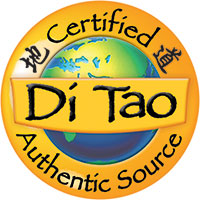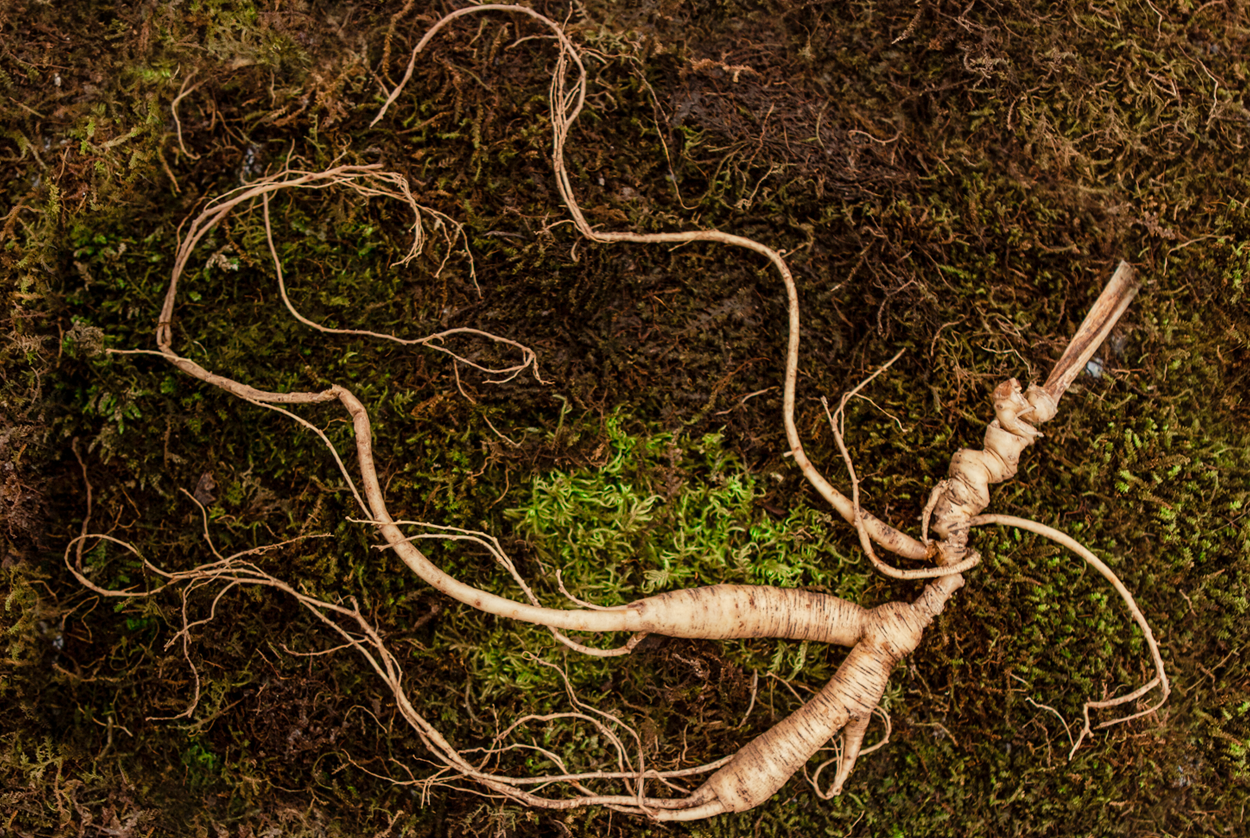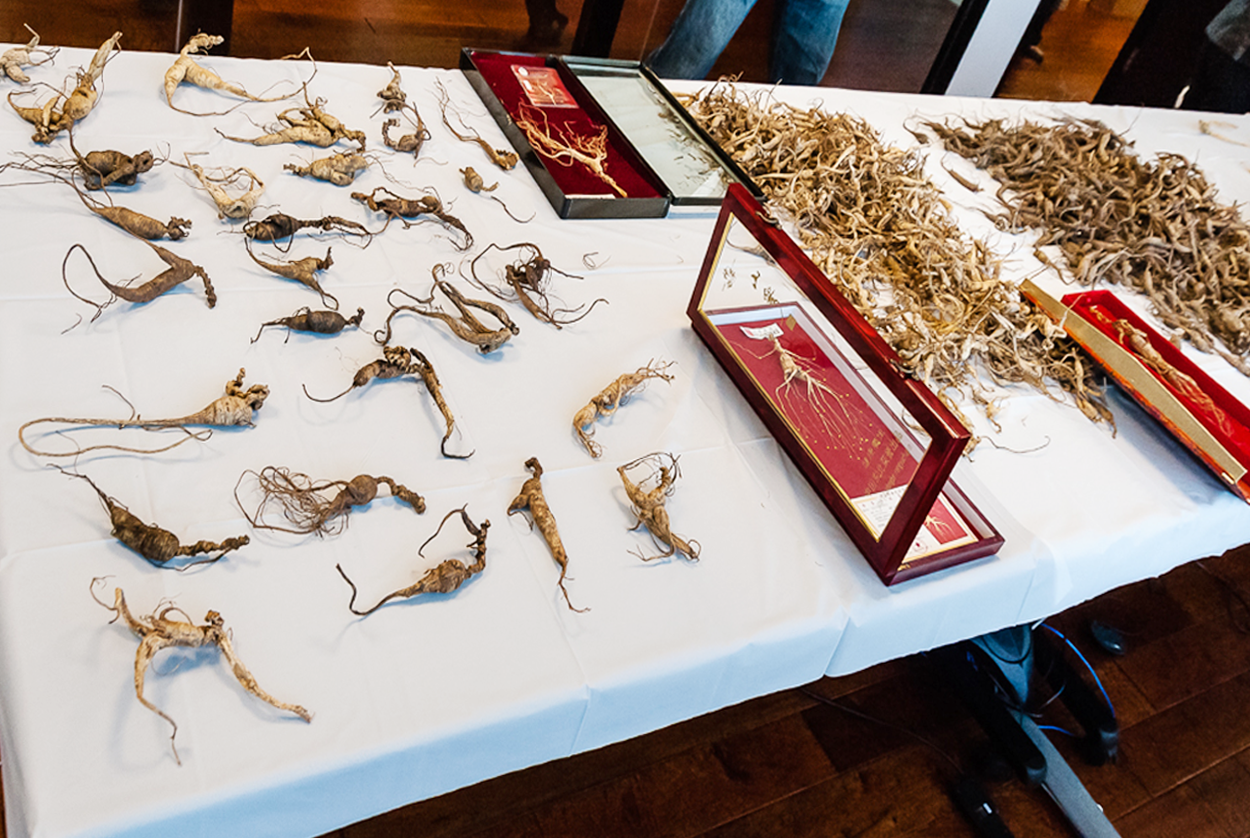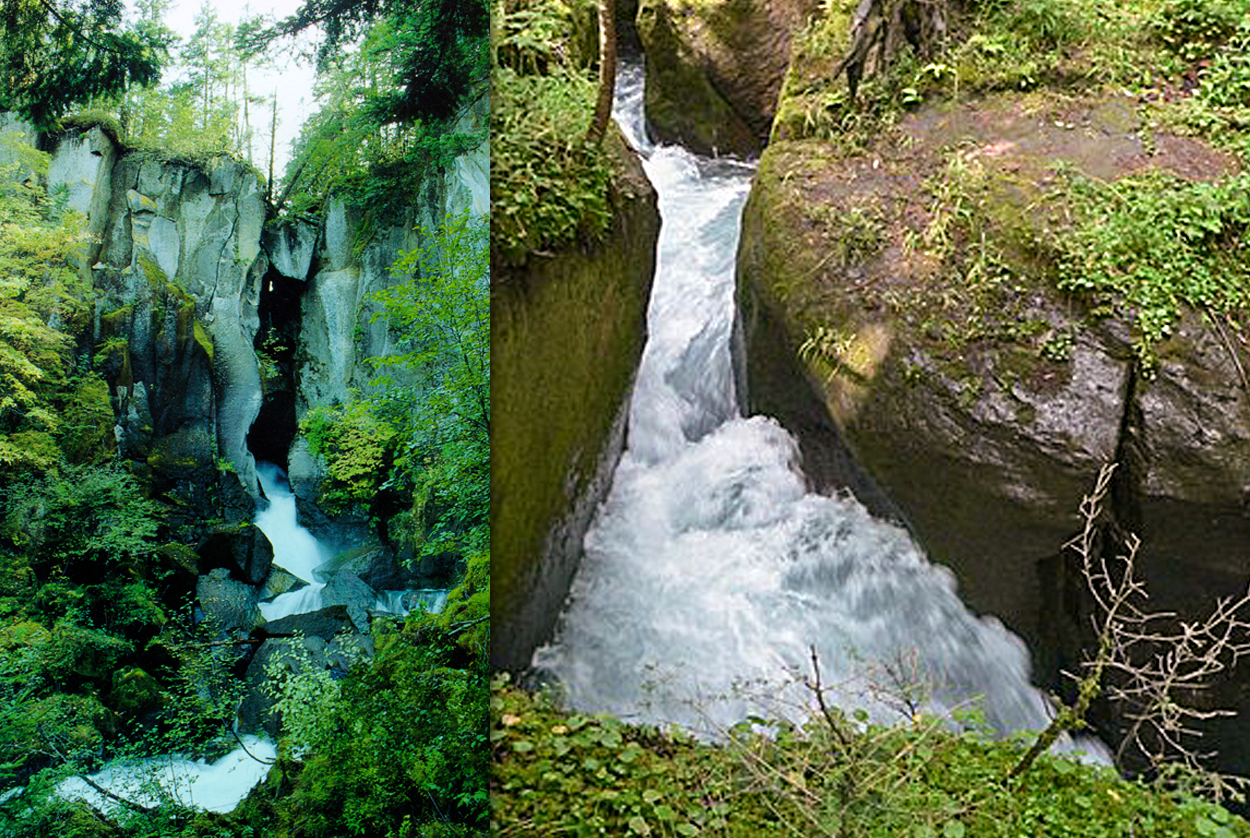This is a demo store. No orders will be fulfilled.
Call Our Herbalists
Herbal Consultations
Heaven Drops 2 oz.- PRIVATE RESERVE
- The ultimate Ginseng extract
- 100% wild Ginseng roots
- Made with hundreds of roots that are over 40 years old
- Over 100 roots that are over 60 years old
- The broadest range of ginsenosides possible
- The Chinese roots are all from Changbai Mountain, Manchuria: all were sustainably collected in boreal forests by licensed Ginseng collectors
- The American roots are all from the Catskill Mountains in New York state: all were sustainably collected in boreal forests by licensed Ginseng collectors
- All roots have been certified authentic by government agencies
- All roots inspected and approved by Master Herbalist Ron Teeguarden and his staff of senior herbalists and herbal scientists
- Thick creamy extremely satisfying extract
- Extracted 6 times to assure complete profile
Product Description
Heaven Drops Wild Ginseng is the crown jewel of the Dragon Herbs brand. Since the very beginning of herbalism in Asia, Ginseng has been revered as the ultimate herb. Chinese Ginseng is called Panax. It has been recognized as a tonic herb that supports glowing health, longevity, mental and sexual wellbeing, and physical vigor. Of course, thousands, or even just dozens of years ago, Ginseng was primarily available only to those who found it growing wild in the pristine forests of Northeast China and other areas where related varieties grew. Large scale Ginseng cultivation was developed only in recent history, but since that time, Ginseng has become one of the biggest natural herbal commodities in the world. Nevertheless, WILD Ginseng is still considered to be the ultimate form of Ginseng. Wild Ginseng has always been, and continues to be, a rare and expensive herb. But in terms of value, it is indeed quite reasonable. Wild Ginseng is one of the great prizes of Nature. This is why Ron Teeguarden has put so much time and effort into identifying reliable sources of genuine wild Ginseng. Ginseng can be found growing in the wild in the awesome Changbai Mountain, a massive active volcano in Manchuria, and in the beautiful and remote regions of Catskill Mountains in North America. There is never easy access to the growing areas where Ginseng can be found. Ginseng hides, and it grows in odd places not easily accessible to humans. Ginseng roots can live to be hundreds of years old in the deep forests, in spite of the fact that humans seek it like gold and forest animals eat it with gusto when they can. Heaven Drops Wild Ginseng is made of a variety of wild Ginsengs. This is a unique product, unmatched anywhere in the world. Each batch is slightly different from any other before or after it. These are wild roots, most of which are decades old and each with a character of its own. Heaven Drops is a priori NOT a standard commercial product. It is a piece of art, an exquisite expression of Nature. There would be many who would say that consuming even one bottle in a lifetime would change one’s life forever. Wild Ginseng, no matter what variety, is considered to be a holy herb, and since ancient times has been an herb of mystics, holy men and women and spiritual seekers. It is also a power herb, sought after by emperors, kings, queens, warriors and those interested in the sexual arts. Due to the rarity of the herbs and production limitations, this product is not available at all times.
Ingredients: Wild American Ginseng root (dried and fresh),Wild Chinese Ginseng root (dried and fresh)
What is Wild Ginseng?
Ginseng, the root of Panax species, is a very well-known tonic herb. It has been used as a tonic in China, Korea and Japan for thousands of years. Ginseng occupies a prominent position in the herbal best-seller list and is considered the most widely taken herbal product in the world. Ginseng is currently one of the most popular herbs used nutraceutically, with an annual sale of over $200 million (probably much higher). It is estimated that more than six million Americans regularly consume ginseng products. As it has been for thousands of years, it is mainly used to as an adaptogen to increase resistance to physical, chemical (toxic) and biological stress, to boost general vitality, to improve mental power, to slow down aging, and to prolong the years of one's life.
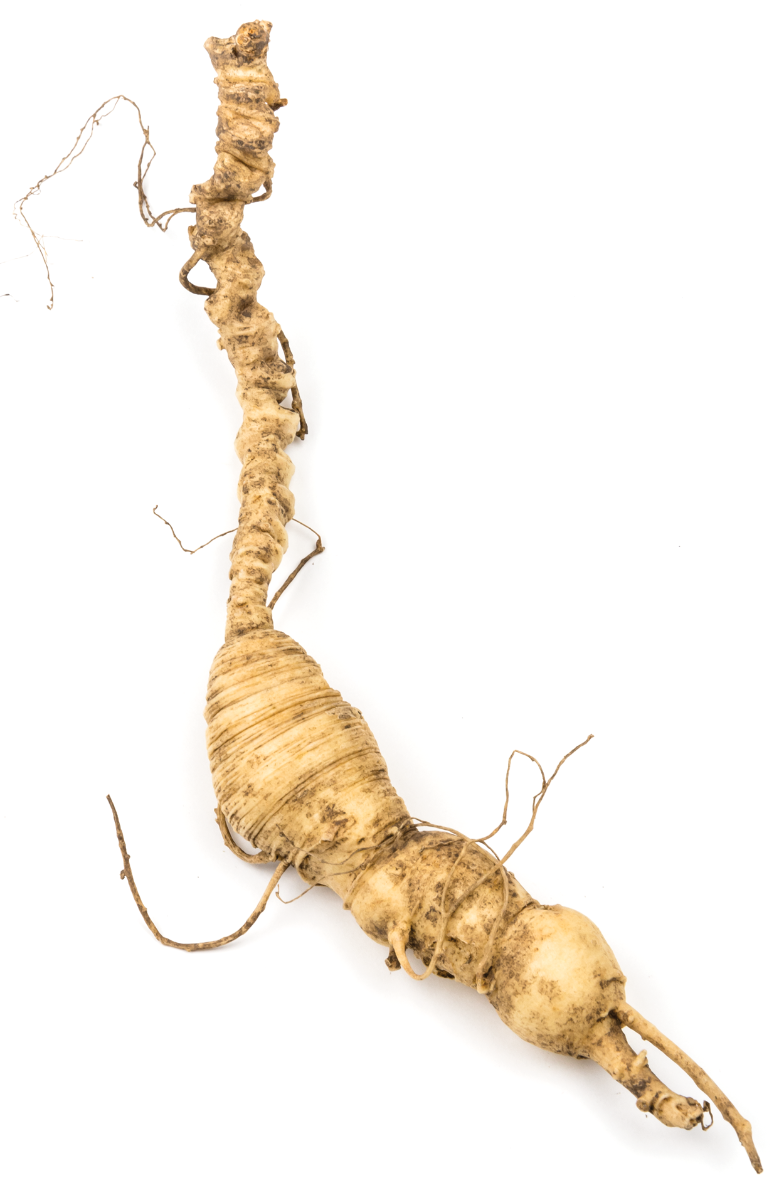 Ginseng products are popularly referred to as "tonics," a term that has been replaced by "adaptogen" in much of the alternative medicine literature. The term "adaptogen" connotes an agent that purportedly increases resistance to physical, chemical, and biological stress and builds up general vitality, including the physical and mental capacity for work. Both American and Panax (Asian) ginseng roots are taken orally as adaptogens, aphrodisiacs, nourishing stimulants, and in the treatment of sexual dysfunction in men.
Ginseng products are popularly referred to as "tonics," a term that has been replaced by "adaptogen" in much of the alternative medicine literature. The term "adaptogen" connotes an agent that purportedly increases resistance to physical, chemical, and biological stress and builds up general vitality, including the physical and mental capacity for work. Both American and Panax (Asian) ginseng roots are taken orally as adaptogens, aphrodisiacs, nourishing stimulants, and in the treatment of sexual dysfunction in men.
The species name “Ginseng” comes from the Chinese word ren shen which means “human-like root” (a lot of people call it "man root") because ginseng roots resemble a human body. Ginseng is believed to be rich in "three treasures" – Jing, Qi and Shen. Jing is the ancestral genetic energy that determines the power of our life and our life span, Qi is our vitality and protective energy, and Shen is our mind, spirit and consciousness. Ginseng is a tonic to all three treasures, and is referred to as the King of Herbs.
Throughout history, ginseng had been used primarily as a tonic to invigorate weak bodies, to boost mental power, to promote spiritual potency, to calm the nerves, to increase the vitality of warriors, workers and athletes, to enhance sexual power, and to help the restore bodily balance (homeostasis) after periods of depletion due to overwork, stress, trauma or illness. Ginseng is considered to be the ultimate Qi tonic herb in the world, and is capable of quickly and profoundly restoring spent Qi in those who consume it.
Until the middle of the twentieth century, most ginseng was still collected in the wild for use by those who could afford it. Panax ginseng was first cultivated around 11 BC. But the wild variety remained most in demand. In the last fifty years of the 20th century, cultivation of ginseng was tremendously developed and this formerly extremely rare and precious herb became available to the masses. First the Koreans, then the Chinese, mastered the modern horticultural art of growing excellent ginseng on plantations. Ginseng takes many years to grow -- at least four years for anything decent, and 6 to 10 years for something good or excellent. The process of large scale cultivation was not easy to develop. Ginseng only grows well in very harsh alpine climates and is susceptible, when young, to many environmental factors that can kill it. Without the use of chemicals, cultivated ginseng would have been very difficult to establish as an industry.
Ginseng's Adaptability
Ginseng is related to the carrot. But unlike a carrot which can only survive for a couple of years, ginseng can survive in the wild for hundreds of years. All natural plants in nature are hardy, and face dramatic challenges in their own environments. But ginseng is one of the hardiest plants of all. It is soft like a carrot, it is small, and does not have hard protective bark or toxins to protect it. Yet it can adapt to an enormous range of stresses and actually survive for decades or even centuries. It's only weakness is that it is one of the most revered herbal foods of humans, and most ginseng roots succumb only when they are plucked by a human. Bears and deer also like ginseng. It's strength is thus its weakness. If it were toxic or non-beneficial to humans, it would be one of the most abundant plants in the northern forests of the world. Its "adaptability" is its key feature.
Age
Ginseng (Ren Shen) means "Man Root" in Chinese, which includes the concept of woman. Ginseng roots can look strikingly human. But other factors were related to the naming of this plant after the human species. One of the observations that were made early on was that ginseng ages in a similar way to humans - at least in terms of obvious life cycle.
Ginseng baby plants are born vulnerable, just like human babies, and grow under the cover of the parental ginseng plant. Young plants are susceptible to attack by fungus, worms and birds, and thus many do not survive the early stage of life. Though they develop some maturity over the first decade, they are not fully mature until they are about twelve to fifteen years old, at which point they have achieved ginseng adulthood. Then they typically live, if not killed by prey (humans, bears and deer), for one hundred years or longer.
Ginseng will live for decades if it gets past its first few years of vulnerability. Ginseng plants over 300 years old have been found, and roots as old as any human are relatively common. Considering the fact that when they're found, they're plucked from the ground, which of course reduces their population and frequency, this is an astounding accomplishment.
How do they live so long? First, ginseng grows in very harsh places. Ginseng likes to live where the weather gets very cold in the winter, but needs warmth in the summer. They grow best in mountains rich in minerals. So they grow in alpine regions. Also ginseng can hide. They tend to grow in inaccessible places like ravines. This adaptation has allowed them to avoid being eaten by deer, bears and humans for tens of thousands, and perhaps millions of years. They easily camouflage themselves among other plants and thus avoid being eaten. Wild ginseng roots are hard to find. 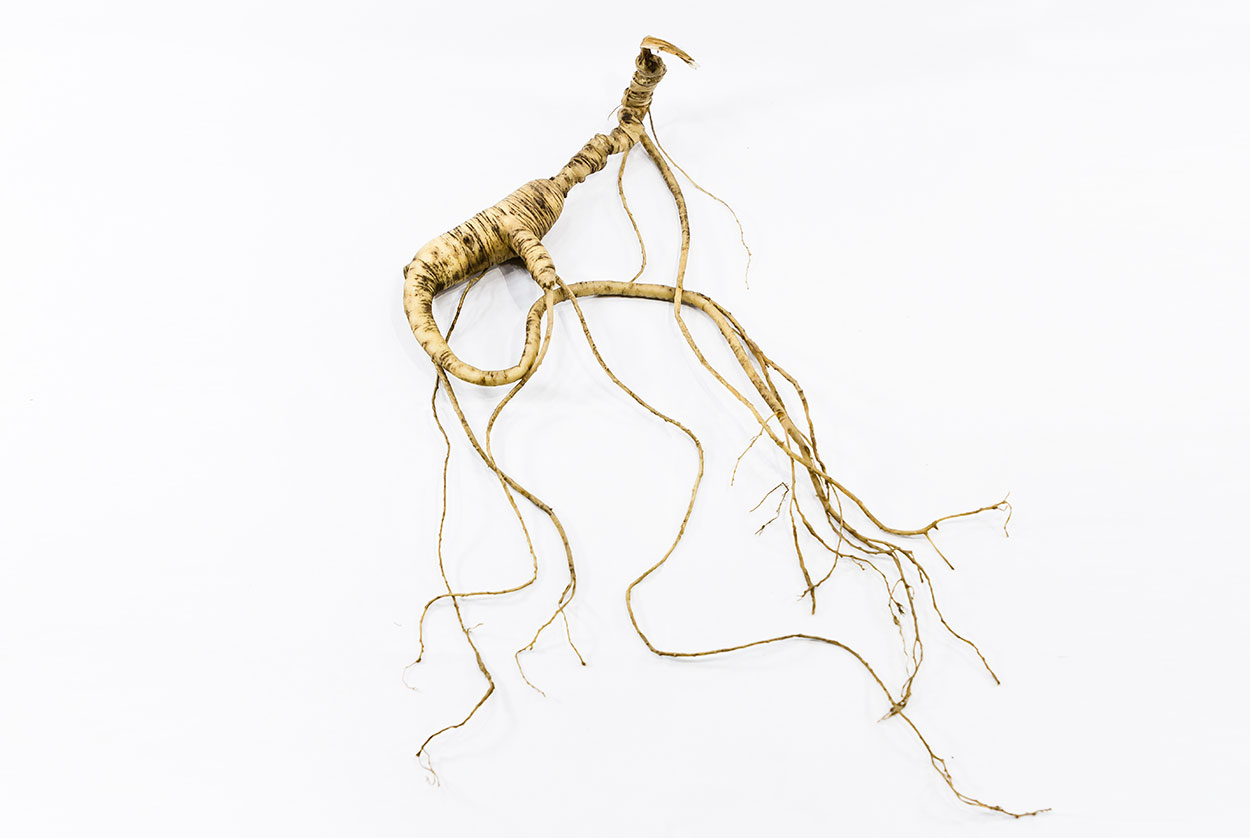
Recent genetic research in Asia indicates that ginseng is genetically pre-disposed for longevity due to a unique genetic mechanism. There are indications that when ginseng attains an age of about twelve or thirteen years in the ground, regions of the cell that include a section of its DNA and structures in the cytoplasm of the cell and cell membrane, known as the Death Domain, "down regulates." The cells become less reactive to factors that would normally cause a cell to die. As a result, ginseng becomes almost immortal. The three hundred year old root found in 2007 in Changbai Mountain showed no signs of age-related degeneration or disease. It may have lived a thousand years or longer if it had not been found and dug up (that root sold for $450,000).
Certain unique sensors, termed Death Receptors on the surface of certain cells, are also turned way down in ginseng as it become "adult." Death Receptors detect the presence of extracellular death signals and, in response, normally ignite the cells intrinsic "apoptosis" machinery. Apoptosis is a cell suicide mechanism that has many beneficial effects, but also ends up resulting in aging and death in most species of multicellular plants and animals. With apoptosis being limited in ginseng, the ginseng root ceases to be at a threat of dying from old age.
A number of members of the Death Receptor family in ginseng have been identified. They control the Death Domain in the nucleus, cytoplasm and cell walls (membranes) of the cells. Ginseng's mechanism for dealing with Death Domain stimulation appears to promote activation and expression of survival genes that may contribute to ginsengs surprising longevity.
Determining the Age of a Ginseng Root
Pearl Dots
The roots and root hairs of wild ginseng will have small bulbs known as "pearl dots." Pearl dots are not present on cultivated roots. This is the first thing every ginseng buyer checks to make sure the ginseng root is authentically wild. It is not possible to fake pearl dots.
Striations
Wild ginseng roots are generally striated. Striations are lines that develop around the root at small intervals, reflective of the stress experienced by the root in its survival process and due to cycles the ginseng plant experiences. Highly striated roots are generally stronger, and more potent nutraceutically as an adaptogen. True striations of real wild ginseng are beveled, meaning the area between striations is raised. Cultivated ginseng generally has no striations, or very few at best.
However, because of the high value of wild ginseng compared to cultivated ginseng, many fake "wild" ginseng roots are created for sale in China to unsuspecting, unsophisticated buyers. Part of the process of creating this so-called "art ginseng" is to carve striations into a cultivated ginseng root with a razor to give it the appearance of a wild root. The striations can appear quite real at first glance, but upon close inspection there is a very big difference in the real striations of a true wild root and those carved in. The rounded beveling in between the striations is a primary indicator. 
Head Length
The "head" of the ginseng is actually its rhizome, the part of the ginseng root that grows at the surface of the earth and from which the above ground part of the plant emerges during the warm months of the year. A ginseng root puts up exactly one sympodium ("stem") each year.
Wild ginseng root heads are elongated. Each year, a new notch is formed at the end of the existing rhizome (head). Eventually, the head can become quite long. Therefore, the longer the head, the older the root. The more notches, the older the root. A root with 20 notches in the head is 20 years old, and a root with 100 notches in the head is 100 years old.
Ginseng counterfeiters can produce fake heads. They do this by taking many short heads from cultivated roots and gluing them together to look like a long head. The unsuspecting buyer will look at the long head and go "Wow, this is an old root!" But close inspection easily reveals the glued seams of the fake rhizome. It's impossible for counterfeiters to get the color and texture of their glue exactly right. We check every root in Heaven Drops for the reality of the rhizome's length. Luckily, our vendors are certified and are very professional and trustworthy. We have worked with them all for a decade or longer. So we don't ever find any "art ginseng" during our final inspection. But we see "art ginseng" for sale in China, especially in cities frequented by western tourists, and even more so in herb shops in American Chinatowns. Many Americans are easily fooled by the "art ginseng" rip-off, including some herbalists who consider themselves professional but are unaware of the counterfeiting. If we do buy a root or roots from a new vendor, we look at the roots under a magnifying glass, paying primary attention to the head, pearl dots and striations.
Gnarliness
Ginseng roots are the king of adaptogens because they themselves are so adaptive. Every stress and challenge they encounter encourages the production of more, different ginsenosides, that provide the ability to cope with the stressor. So the stress the plant has experienced determines the potency of the root as a human tonic.
The quality I call "gnarliness" is absolutely an essential factor in determining the potency of a wild root. A root that has been exposed to attacks by bugs, harsh weather shifts, even fungus, will be much uglier than one that was not exposed to these challenges. They will grow "gnarly." For my own personal use, I never choose a smooth fancy root. I choose the ugliest one I can find because i know it stood the test of stress. A good worm bite, a crooked body, rough skin, even some discoloration, all tell me that this is a great root. To us "ugly" is beautiful. We use a lot of ugly roots to make Heaven Drops. Of course, some roots are straight and unblemished, and still they're ancient roots, These roots are still incredibly valuable and beneficial - they lived for decades if not centuries. But for your classic 40 year old wild ginseng root, gnarly is very, very cool.
Size
The size of a ginseng root can vary dramatically, Wild roots can be very small, big or even very big. The determining factors are soil condition, weather, age, and probably some genetics. It has been demonstrated that small wild roots can be dramatically enlarged under certain favorable conditions, but enlarging them does not increase their potency - perhaps the contrary. Small, old roots have lived hard lives and have developed amazing ginsenoside profiles to survive (or thrive). To us, a small yet very old root is miraculous and extremely great.
A very robust root may get larger, or longer. Long roots are considered propitious. They have grown well into the ground to survive and often have the strongest actions. I have seen a root that is nearly 5 feet long. Actually, it takes quite a collector to find such a root and to take the care and time (muscle and patience) to dig out a root that is several feet long. These roots are very thin and fragile.
Roots can grow to be quite large if they have been blessed with a very hidden location and excellent soft soil. A very old, large root will fetch the most value at the market. But the large root may or may not be any better than a smaller root that has experienced significant hardship and survived to old age.
So there is one more quality that is essential in understanding the beauty and potency of a wild ginseng root.
Taste
Wild roots taste a little different than cultivated ginseng roots. They have a "bite." The spiciness can stick in your throat, but goes away in a minute or two. Still, wild ginseng tastes very good. Proper, conscious extraction mellows out the flavor without changing the effect.
Traditional Use of Ginseng
Ginseng has been used for thousands of years to boost general vitality, and to provide protection by increasing resistance to physical, chemical (toxic) and biological stress.
Shennong, the Father of Chinese Herbalism and author of the most important herbal compendium in history described ginseng like this:
"The root of ginseng vitalizes the five organs, calms the nerves, stops palpitations due to anxiety, brightens vision, improves one’s intellect, removes "evil energy” (pathogenic factors), and with prolonged use, prolongs life and makes one feel young.”
These are the fundamental traditional uses of ginseng, and these are still considered to be the primary benefits of consuming ginseng for a prolonged period of time. 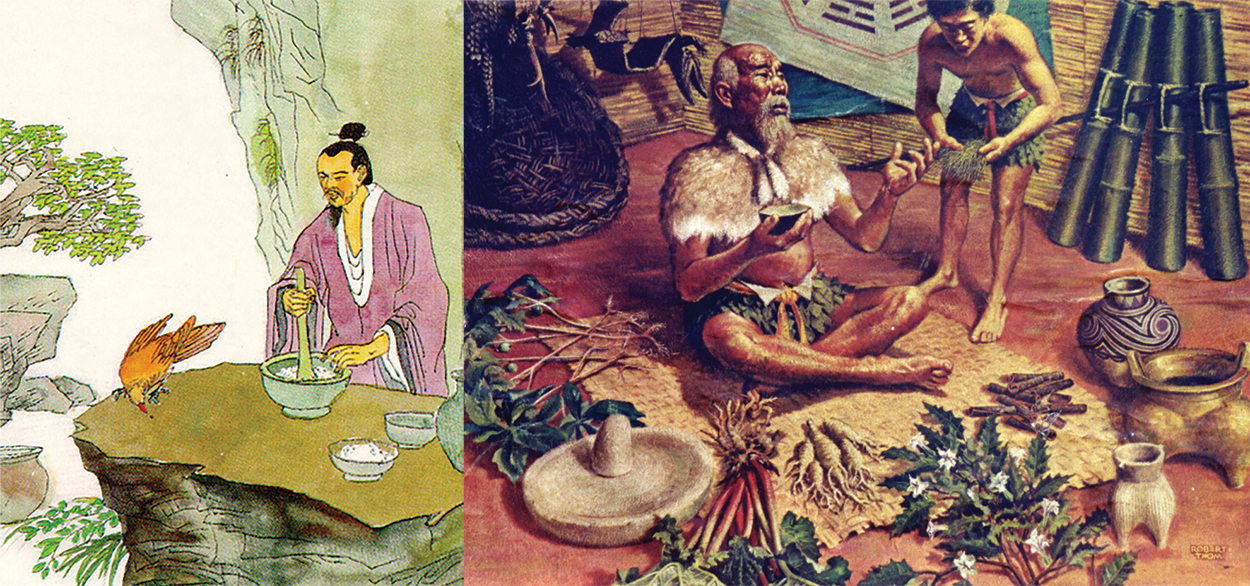
General Well Being
Ginseng products are usually used as a general tonic and adaptogen to help the body to resist the adverse influences of a wide range of physical, chemical and biological factors and to restore homeostasis. These tonic and adaptogenic effects of ginseng are believed to enhance physical performance (including sexual function) and general vitality in healthy individuals, to increase the body’s ability to fight stress in stressful circumstances and to support resistance to diseases by strengthening normal body function as well as to reduce the detrimental effects of the aging processes.
Yin and Yang
As an adaptogen, ginseng possesses the ability to help regulate Yin-Yang balance in the body. Younger ginseng roots (less than 6 years old) tend to have more Yang ginsenosides and have not yet developed the Yin ginsenosides. As a result, though they are commercially viable and widely distributed, roots of this age are in fact "immature" and can have the side effects associated with too much Yang and too little Yin, including tension, headaches, anger, etc. The wild ginseng roots used in Heaven Drops are at least twelve years old and have developed a complete compliment of ginsenosides, both Yin and Yang, in the proper balance for the species.
Though American ginseng possesses plenty of both Yin and Yang ginsenosides, it contains a slight preponderance of Yin ginsenosides. As a result it is considered to be a Yin herb.
Though Chinese ginseng possesses plenty of both Yin and Yang ginsenosides, it contains a slight preponderance of Yang ginsenosides. As a result it is considered to be a Yang herb.
Heaven Drops contains hundreds of Chinese ginseng roots and hundreds of American ginseng roots, in about a 7:3 ratio of wild American roots to Chinese roots. The result is a perfect balance of Yin and Yang energy, well suited to most humans.
Jing, Qi and Shen
Jing, Qi and Shen are the Three Treasures, the three primary types of energy that animate each of us and give us life.
Jing is our "root energy," the ancestral energy transferred to us genetically from our parents. Jing determines the power of our life and how long we can live. We use up Jing every day - it is kind of like the wax of a candle that is used up by life itself. Stress, hard living, disease and inflammaging burn up our Jing even faster, resulting in premature aging, degeneration and death.
Qi is our vitality. It is the day to day energy we produce as living beings based on our metabolism (diet) and respiration (breath). If we produce an abundance of Qi, we can live a robust, vital life. An abundance of free flowing Qi gives us the ability to adapt to changes in the environment, changes that take place every moment of our life. Qi also is the energy of our immune system, so an abundance of Qi promotes the ability to resist disease.
Shen is our mind, our consciousness, our Spirit. Shen is the higher state of mind we associate with spiritual awareness and mastery. Shen is innate, but is hidden when we are addicted to emotions like worry, fear, anger or obsession. All people on spiritual paths seek to dissolve these negative emotions and open Shen, no matter what they call it. Freedom from the addiction to the emotions, associated with being totally guided by Shen, is called enlightenment or nirvana. It takes some form of meditation to achieve this state of being.
Wild ginseng is the King of Herbs. It has been revered since the dawn of human civilization by the spiritual masters. It stores energy from the earth in the form of Jing, provides the most Qi of any herb on earth and is the quintessential Shen tonic. Taoist sages have used ginseng specifically to enhance all Three Treasures for over four thousand years.
Five Elements
There are 5 elemental energies: Water, Wood, Fire, Earth and Metal. Old wild ginseng contains all 5 elements in a perfect balance, unlike younger ginseng roots. Our human body is composed of these 5 elements. Wild ginseng thus influences and helps regulate all major bodily and mental functions, according to traditional theory.
Emperors, Imperial Women and the Wealthy
Wild ginseng has always been very precious. It is rare and it is very beneficial. It directly influences one's life in a positive manner. As a result, it has always been coveted by people of means. The first king of Korea is credited with having discovered it by divine guidance. The emperors of China had their own personal ginseng plantations and wild reserves in the most perfect locations. Even today, the King of Bhutan maintains vast lands where Himalayan ginseng grows - and it is illegal for anyone to harvest it except for use by the King and his family.
Wild ginseng is very, very good for women. As a result, it was used by the imperial women of China, Korea and Japan. Today it is used by Asian women who can afford it to maintain their youthfulness and beauty.
As described above, old wild ginseng roots can be very expensive, so wild ginseng has often been associated with the wealthy classes. Nevertheless, the less advantaged people who have been fortunate enough to find it consider it a supreme treasure. Heaven Drops is actually very economical, because many people are sharing many roots extracted with highly effcient modern technology. It's a way of making wild ginseng much cheaper. Just buying one root could easily cost several hundred dollars, but with Heaven Drops you're getting the benefit of many roots, and the profile of 1,000 roots. 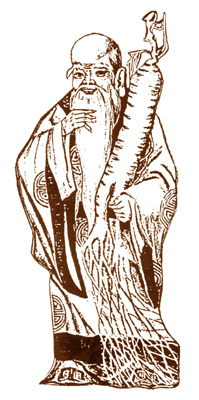
Sages
The other class of people who traditionally used wild ginseng all the time were the sages, Taoist masters and Taoist hermits. These people had access to wild ginseng roots because they lived in the mountains and often collected the roots themselves. Along with reishi mushroom, wild ginseng is the most important herb in the spiritual-diet of the sages of the Orient. This will never change so long as there are seekers.
Revitalization
Wild ginseng's power of revitalization is one of its key features. There is no end to the stories of how wild ginseng brought people back to radiant health after periods of great challenge. No herb in the world matches wild ginseng's reputation in this regard. There are numerous legends of people raising from the brink of death after consuming an old wild ginseng root. This is of course not a medical claim, but legend that implies the potency of wild ginseng to restore the Three Treasures, quickly and safely, even after severe depletion.
No herb could be better consumed than wild ginseng after a period of high stress or extreme energy output. Before, during and after the battle, take your Heaven Drops!
How to Use Heaven Drops Wild Ginseng
Heaven Drops Wild Ginseng is a tonic formulation made from a variety of wild ginseng roots. It is the quintessential example of an adaptogen, an agent that increases resistance to physical, chemical and biological stress and builds up general vitality, including the physical and mental capacity for work. Both American and Panax (Asian) ginseng roots are taken orally as adaptogens, aphrodisiacs, nourishing stimulants, and to help establish and maintain healthy functioning of the heart, brain, lungs, thymus, liver and other systems of the body.
It is reasonable to take from one to four squirts a day of Heaven Drops, based on how you feel and upon your needs. Taking more, up to nine squirts a day is fine for some people, and some people do very well on just one squirt a day. A squirt is created by fully squeezing the plastic head of the dropper one time. The dropper will fill up about half way.
It may be taken straight into your mouth, or it may be squirted into a beverage. Squirting it into Tonic Alchemy, Spring Dragon Longevity Tea or a juice are also excellent ways to take Heaven Drops. Or it can be mixed into an herbal tonic such as those served at the Dragon Herbs Elixir Bar in Los Angeles/Beverly Hills, to direct its actions.
Heaven Drops Wild Ginseng is the ONLY product in the world made 100% from genuine wild ginseng, featuring ultimate quality wild roots from ginseng's true Di Tao (authentic) sources. It contains a number of roots over 50 years of age.
Authentic Sourcing - Di Tao
The deeply insightful concept of sourcing used in tonic herbalism has helped insure quality control for over 2000 years. Di Tao means "authentic, original sourcing." By this principle, it is essential to obtain herbs that have grown in their natural source of origin, where they have proven to have beneficial functions for centuries. When an herb is grown in a different environment than its original growing environment, it usually loses its balance, potency and efficacy. Dragon Herbs is a Di Tao company. We source all of our herbs from their Di Tao source.
The ginseng used in Heaven Drops is Di Tao. We have used just two species in the current batch. Both species have been considered the original, authentic, best source for centuries.
The Di Tao of Asian Ginseng
We get our Asian ginseng from only one area, Changbai Mountain. This is where the best ginseng in the world has grown naturally for a million years, and is where it was first discovered over 4,000 years ago. Changbai Mountain lies in both North Korea and Manchuria. Ours is collected primarily on the Chinese side of the border. No other source of Asian ginseng compares in quality, richness and effectiveness. The majority of our roots are certified by Chinese government agencies to be authentic Changbai Mountain ginseng roots.
In this particular batch of Heaven Drops, we purchased a supply of amazing roots from some collectors (a village) in Changbai Mountain. Some of the villagers had observed a patch of ginseng roots growing in the mountain. One day a swarm of birds flew down are ate the entire "crop" of fruit with ripe seed. The farmers knew the patterns of these birds and followed them. The birds flew to a secluded region of the forest to roost. The next year, the seeds that had been consumed by the birds sprouted. The farmers watched the ginseng grow for twenty years and then collected them. They were very excited about the potency of these "bird sewn" wild ginseng. It may be a common way that ginseng is spread from one part of the forest to another. We purchase approximately 150 of these roots and extracted them in this batch. They are the youngest ginseng roots in this batch of Heaven Drops, but they are very strong tasting, had beautiful long rhizomes and excellent striation.
We also used thirty five premium old ginseng roots that had been collected in the mountains, and certified by the government as to their age (all over thirty years old). Then we used some roots that were certified authentic, and were in the sixty years old and very expensive.
The Di Tao of American Ginseng
American ginseng was discovered by the Europeans in America about 400 years ago, but it had been used by native Americans from prehistoric times. American ginseng is native to America at least since the end of the last ice age. It may have originated from Asia, but has had tens of thousands of years to adapt. It grows naturally throughout the eastern and northern United States and in many areas of Canada. An area that borders New York state and Canada is considered to yield the most potent, well-balanced, efficacious ginseng. This is the Catskill Mountain region, which fortunately remains largely pristine. Dragon Herbs only collects wild American ginseng from the remote, mountainous, forested, mainly uninhabited regions of the Catskill Mountains. All of our roots are collected legally by licensed ginseng collectors who abide by federal and state laws that regulate collection. No young roots are collected (which is good for us).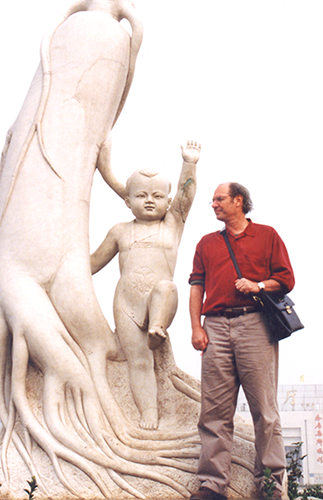
The Value of Wild Ginseng Is Well Established
Wild ginseng has been a hot commodity for over four thousand years. The value for wild roots from Changbai Mountain is well established.
A hundred year old wild ginseng root collected from Changbai Mountain was recently sold in an auction in Guangzhou, China for 1.88 million yuan (US$250,000).
But this was not the most expensive ginseng root ever sold in China. Many roots have sold for more. For example, in July 2007 a 300 year old wild ginseng root was found on Changbai Mountain. The root weighed over 13 ounces. This ancient "grandfather root" quickly sold for 3 million yuan (US$400,000)!
What is the difference between wild and cultivated ginseng?
Wild ginseng is natural, and has not been planted or manipulated in its growth by humans. It grows in the forest just as it has for a million years. Cultivated ginseng is grown from seeds by humans. Most cultivated ginseng is grown on ginseng farms, which are small or large plantations that specialize in ginseng cultivation. Cultivated ginseng will usually only be allowed to grow for 3 to 6 years before harvesting, and is usually subject to the use of some chemicals.
There are important exceptions to this procedure. Some plantations in America, China, North Korea and South Korea grow premium ginseng roots at high altitude, using virtually organic methods, and allow roots to mature for up to ten years before harvesting. High quality ginseng costs much more than low quality ginseng - and is well worth it. Wild roots often live to be many decades old before they are eaten by an animal or collected by humans. A wild ginseng plant found in Manchuria in 2007 was more than 300 years old. It sprouted before Benjamin Franklin was born! And though it's a soft, carrot-like herb, it survived for three centuries under extremely harsh conditions.
Ginseng is a "buyer beware" situation. Dragon Herbs is the only company we are aware of in the United States that uses only the premium "Heaven Grade" cultivated and wild ginseng roots to make all of its ginseng products. In our Heaven Drops, we use only wild ginseng.
Beware of Cheap Ginseng
These days, almost all ginseng sold throughout the world is cultivated. Currently most ginseng is grown with the use of some chemicals, and typically only for 4 to 5 years. This non-organic, short growth-period ginseng is the common ginseng found in most products in the United States. The chemical profile of these young roots has not yet fully matured and is actually imbalanced. It is too yang (it is too deficient in yin factors). When a root is 6 to 8 years old, it achieves a certain level of maturity, a maturity based on balance of Yin and Yang factors in the phytochemistry of the ginseng. Still, roots develop more ginsenosides as they grow even older, but after they are eight years old, they are at least balanced.
The relatively inexpensive, chemically grown, short-period ginseng is sold to unwitting consumers all around the world based on the reputation ginseng acquired as a wild herb, or on high grade cultivated roots. Much of this cheap ginseng should not be sold. It is immature, with a poor phytochemical profile that results in side effects in many people. Ginsengs misbegotten reputation for causing high blood pressure and headaches is the result of cheap ginseng that has flooded the market in recent decades. It is understandable that farmers would harvest ginseng as soon as possible - every year they leave the ginseng in the ground is a year without making a sale. Every year they leave the ginseng in the ground is risky, since the whole crop could be lost to the environment. Still, this is not the most beneficial situation for the consumer. It takes considerable patience and will power to let ginseng stay in the ground for eight or ten years. Wild ginseng, of course, is not cultivated, so it is generally collected when it is found so long as it is over twelve years old.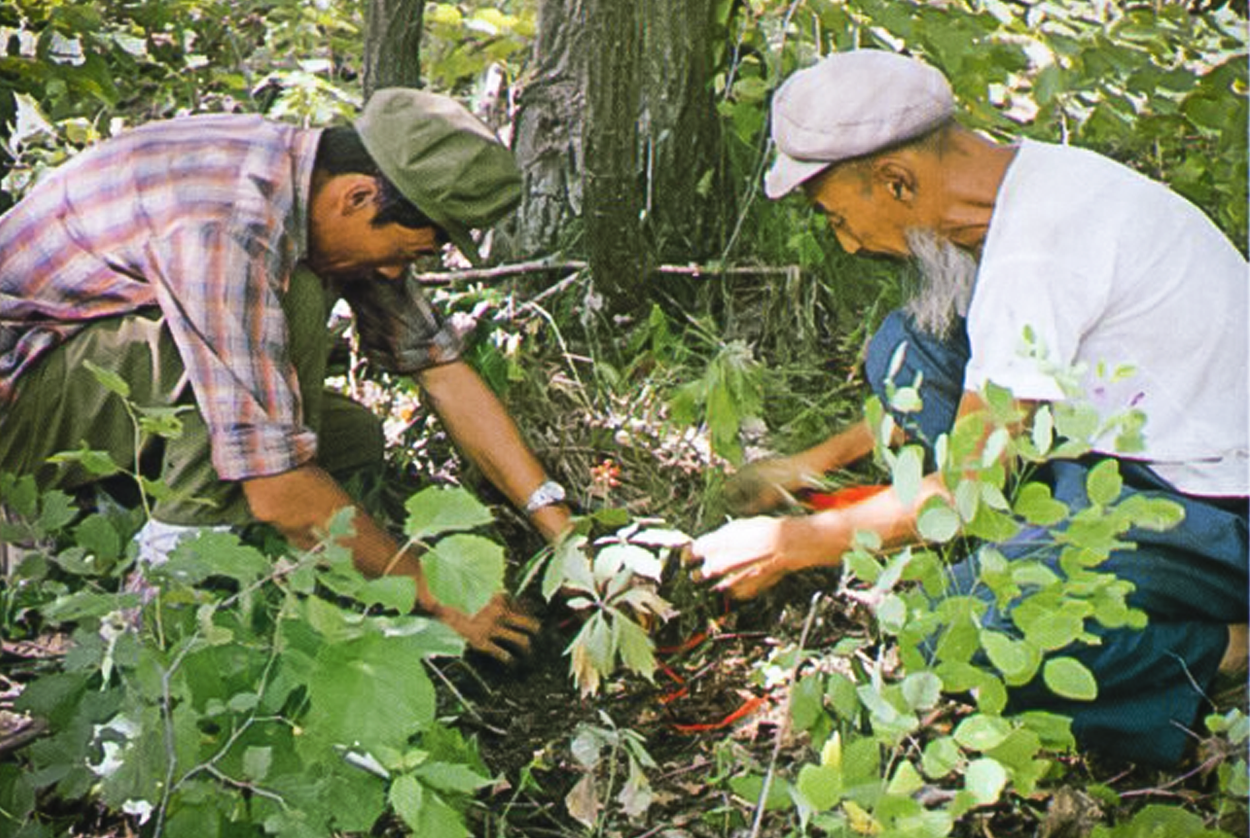
High Quality Ginseng Will Not Cause Side Effects
Ginseng can be cultivated without the use of chemicals, and ginseng can be left in the ground for as many as ten years, using thoughtful organic or nearly organic methods. Dragon Herbs uses only these naturally grown, long cultivation ginsengs in its various ginseng products. High quality ginseng, and especially wild ginseng (which is better than just "high quality" ginseng) will not cause the common side effects sometimes associated with ginseng when used reasonably. Wild ginseng, the most valued and precious ginseng, is notoriously "mild," meaning it has no side effects because of its extraordinary phytochemical balance and profile.
Ginseng is known as the "King of Herbs." But this is only true of the wild variety and of the best cultivated varieties (so-called "Heaven Grade" roots). Most ginseng on the market is actually not worth consuming. On the other hand, there is nothing better than premium grade cultivated ginseng, and even more so, wildGinseng.
Unfortunately, wild ginseng roots are very rare. They cost many times more than cultivated ginseng -- even the best cultivated ginseng. Nevertheless, wild roots can be obtained, not by the ton, but by the gram, from specialists. Hong Kong is today the world center for selling true wild ginseng, but the prices you pay in Hong Kong are anything but cheap. A single typical wild ginseng root can sell for hundreds of dollars, and a root that is 40 or 50 years old - or older - can easily fetch thousands, or even tens of thousands of dollars - for just one root that weighs just an ounce or two. There is currently a wild root available in China that is certified by the government to be the oldest genuine root currently available on the market - it's about 85 years old - and it's selling price is over $50,000. It won't last long on the market because wealthy Asian connoisseurs know its value.


